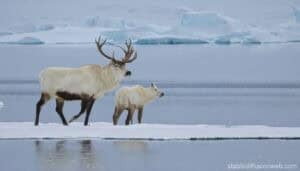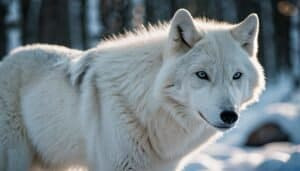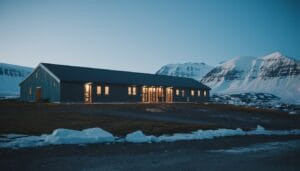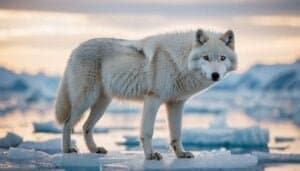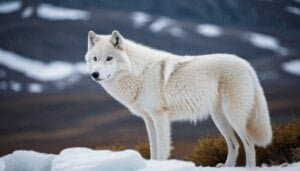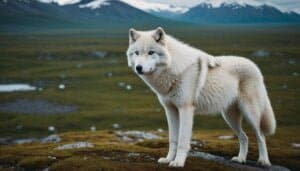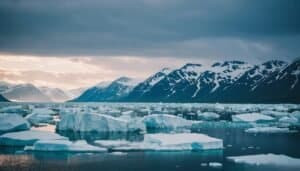Introduction
Arctic wolves play a pivotal role in the environmental stewardship practices of Arctic peoples. These majestic predators are not only essential to maintaining the ecological balance of their habitat but also hold significant cultural value for indigenous communities
This article explores various aspects of the relationship between Arctic wolves and Arctic peoples, including the influence of wolves on hunting practices, their impact on local wildlife populations, and their contribution to the ecological balance
Additionally, we delve into the cultural significance of Arctic wolves and the conservation efforts undertaken by indigenous communities to ensure their survival. Through this exploration, we aim to highlight the integral role of Arctic wolves in the Arctic ecosystem and the traditional practices of its peoples
The Influence Of Arctic Wolves On Hunting Practices
Arctic wolves have long been intertwined with the lives and traditions of the indigenous peoples of the Arctic region. These animals play a significant role in the hunting practices and strategies of Arctic communities, impacting not only the availability of prey but also the methods and timing of hunts
Traditional Hunting Methods
For millennia, Arctic peoples have developed sophisticated hunting techniques that harmonize with the natural behaviors of Arctic wolves. These wolves, known for their keen hunting instincts and ability to traverse vast snowy landscapes, often become indirect partners in human hunting efforts
Indigenous hunters observe wolf packs to learn the movement patterns of prey species such as caribou and musk oxen. By following the wolves’ lead, hunters can locate herds more efficiently, saving valuable time and energy in the harsh Arctic environment
Historically, some communities have even used the presence of wolves as a natural barometer for tracking prey movements. When wolf sightings increase, it often indicates the nearby presence of large prey animals, allowing hunters to prepare accordingly. This symbiotic relationship highlights the wolves’ indirect but crucial contribution to the sustainability of hunting practices in these regions
The Role Of Wolves In Regulating Prey Populations
Arctic wolves are apex predators, meaning they play a crucial role at the top of the food chain. By preying on weak, sick, and old animals, wolves help maintain the health of prey populations. This natural selection process ensures that only the fittest animals survive and reproduce, contributing to the overall genetic health of species like caribou and musk oxen
For Arctic hunters, this predatory behavior is advantageous. Healthy prey populations are more predictable and stable, reducing the risks associated with overhunting
The wolves’ regulation of prey populations also prevents overgrazing, which can devastate the delicate Arctic vegetation. This ecological balance supports the long-term sustainability of both wildlife and human communities
Impact On Resource Allocation
The presence of Arctic wolves influences the resource allocation strategies of Arctic peoples
Knowing that wolves will naturally cull weaker animals, hunters can focus their efforts on targeting the healthiest and most robust individuals. This selective hunting practice is more efficient and humane, aligning with traditional values of respect for nature and sustainable use of resources
Additionally, the scavenging behavior of wolves provides an ecological service by cleaning up carcasses that might otherwise attract disease or other predators. This behavior indirectly benefits human communities by reducing the risk of disease transmission from decomposing animal remains
The mutual respect and understanding between Arctic wolves and humans exemplify a profound connection rooted in survival and environmental stewardship
Arctic Wolves And Local Wildlife Populations
Arctic wolves are integral to the health and stability of the Arctic ecosystem
Their interactions with local wildlife populations are complex and multifaceted, influencing everything from predator-prey dynamics to the overall biodiversity of the region. Understanding these interactions provides insight into the critical role Arctic wolves play in maintaining ecological balance
Predation Patterns
Arctic wolves exhibit unique predation patterns that are essential for regulating local wildlife populations. Unlike many other predators, Arctic wolves often hunt in packs, enabling them to take down larger prey such as caribou and musk oxen
This cooperative hunting strategy ensures that they can efficiently manage prey populations, which is vital for preventing overpopulation and the subsequent depletion of vegetation
Wolves primarily target the most vulnerable individuals within a herd, such as the old, sick, or young. This selective predation helps to cull weaker animals, allowing healthier individuals to thrive and reproduce. The removal of weaker individuals not only promotes the genetic health of prey populations but also ensures that the herds do not exceed the carrying capacity of their habitat
Effects On Herbivore Numbers
The presence of Arctic wolves has a profound impact on the numbers and behavior of herbivores
By keeping herbivore populations in check, wolves prevent overgrazing, which can lead to habitat degradation. Overgrazing can have severe consequences in the Arctic, where plant growth is slow and recovery from damage takes much longer than in more temperate climates
The pressure exerted by wolf predation causes herbivores to move more frequently and graze less intensively in any one area. This behavior disperses the impact of grazing across the landscape, promoting more even and sustainable plant growth. The mobility of herbivores also means that they help to spread seeds and nutrients across the tundra, contributing to the overall health of the ecosystem
Interactions With Other Predators
Arctic wolves do not exist in isolation; they interact with other predators such as polar bears, arctic foxes, and birds of prey
These interactions can be competitive or complementary, depending on the circumstances. For example, wolves and polar bears may compete for the same food sources, particularly in regions where their habitats overlap. However, such competition can also drive diversification in hunting strategies and prey selection, promoting ecological balance
Arctic foxes often benefit from the presence of wolves, scavenging on the remains of wolf kills. This scavenging provides foxes with a reliable food source, particularly during the harsh winter months when other food is scarce
Birds of prey, such as snowy owls, may also take advantage of carcasses left by wolves, further illustrating the interconnectedness of the Arctic food web
The interactions between Arctic wolves and other predators highlight the complexity of the Arctic ecosystem. Wolves play a central role in this web of life, influencing the behavior and survival of various species, which in turn impacts the overall health and resilience of the ecosystem
Ecological Balance And The Arctic Ecosystem
Arctic wolves are indispensable for maintaining the ecological balance of the Arctic ecosystem. As apex predators, they influence various environmental factors, from species distribution to nutrient cycling. Understanding their role is essential for appreciating the intricate dynamics that sustain the Arctic habitat
Wolves As Keystone Species
Arctic wolves are considered keystone species due to their significant impact on the structure and function of the ecosystem. By controlling prey populations, they help maintain a balance that prevents any single species from dominating the landscape. This balance is crucial for preserving biodiversity and ensuring that various species can coexist
The concept of a keystone species was first introduced by ecologist Robert Paine in 1969. Paine’s research demonstrated how the removal of a single predator can lead to dramatic changes in an ecosystem
In the Arctic, the presence of wolves prevents herbivores from becoming too numerous, which in turn supports the survival of other plant and animal species. Without wolves, the cascading effects on the ecosystem could be profound, leading to overgrazing and habitat degradation
Nutrient Cycling And Plant Growth
Arctic wolves contribute to nutrient cycling through their feeding habits and movement patterns. When wolves hunt and consume prey, they leave behind remains that decompose and enrich the soil with nutrients. This process supports plant growth, which is particularly important in the nutrient-poor Arctic environment
The presence of wolves also influences the distribution and behavior of herbivores, leading to more diverse grazing patterns
As herbivores move across the landscape to avoid predation, they spread seeds and nutrients through their droppings. This movement helps to distribute essential nutrients more evenly across the tundra, promoting a more resilient and diverse plant community
Additionally, the predation pressure exerted by wolves encourages healthier and more robust plant growth. Overgrazing by unchecked herbivore populations can strip the land of vegetation, but the regulatory effect of wolves ensures that plants have the opportunity to recover and thrive. This balanced interaction between predators, herbivores, and vegetation is a hallmark of a healthy ecosystem
Habitat Utilization
Arctic wolves influence habitat utilization by both their prey and other species. Their hunting activities can create a mosaic of habitat use, as prey animals alter their movements and feeding grounds to evade predators
This dynamic distribution of animals helps to prevent localized overuse of resources and promotes a more balanced use of the landscape
Wolves also create habitats for other species through their actions. For instance, the remains of wolf kills provide food for scavengers like Arctic foxes and ravens. These scavengers, in turn, play their own roles in the ecosystem, contributing to the decomposition process and nutrient cycling
Moreover, the presence of wolf packs can deter other large predators, such as polar bears, from occupying the same territories, leading to a more even distribution of predator pressure across the region
The ecological footprint of Arctic wolves extends beyond their immediate interactions with prey. Their influence permeates the entire ecosystem, shaping the behavior and survival of various species and contributing to the overall health and stability of the environment
Cultural Significance Of Arctic Wolves
The cultural significance of Arctic wolves extends deeply into the traditions, beliefs, and daily practices of Arctic indigenous peoples. These majestic creatures are not merely wildlife but are woven into the spiritual and cultural fabric of the communities that share their environment
Wolves In Arctic Folklore And Mythology
Arctic wolves occupy a prominent place in the folklore and mythology of many Arctic indigenous cultures
These stories often depict wolves as symbols of strength, endurance, and cooperation, reflecting the traits admired and aspired to by the people of the Arctic. In some myths, wolves are seen as guides or protectors, leading hunters to prey or safeguarding communities from danger
For example, the Inuit people have numerous legends about Amarok, a giant wolf that hunts alone at night. Amarok is often portrayed as a guardian spirit, embodying the harsh and unforgiving nature of the Arctic while also offering wisdom and protection to those who respect it. Such stories reinforce the connection between humans and wolves, emphasizing mutual respect and the understanding of nature’s balance
Symbolism And Spiritual Practices
The symbolism of Arctic wolves is deeply ingrained in the spiritual practices of Arctic peoples. Wolves are often regarded as totem animals, representing certain clans or families and embodying qualities that are important for survival and communal harmony. The spiritual bond between humans and wolves is celebrated through rituals, dances, and ceremonies that honor the animal’s spirit
In some Arctic communities, shamans or spiritual leaders communicate with the spirits of wolves during rituals
These practices are believed to bring guidance, healing, and protection to the community. The wolf’s keen senses and hunting prowess are seen as gifts from the spirit world, providing humans with the skills and knowledge necessary to thrive in the Arctic’s challenging environment
Educational And Communal Activities
Arctic wolves also play a role in the educational and communal activities of indigenous Arctic peoples
Stories about wolves are used to teach children important life lessons, such as the value of teamwork, the importance of respecting nature, and the necessity of resourcefulness. These lessons are often imparted through storytelling sessions around the fire, where elders pass down wisdom to younger generations
Moreover, the observation of wolves in the wild serves as a practical educational tool. Young hunters learn about tracking, survival skills, and animal behavior by watching wolf packs. This hands-on learning fosters a deep connection to the land and its inhabitants, reinforcing the principles of environmental stewardship and sustainable living
The communal activities that involve wolves also include artistic expressions, such as carvings, paintings, and textiles
Wolves are frequently depicted in Arctic art, symbolizing the interconnectedness of all life and the respect for the natural world. These artistic representations are not only cultural expressions but also serve as reminders of the crucial role wolves play in the ecosystem
Conservation Efforts By Indigenous Communities
Indigenous communities in the Arctic have long recognized the importance of Arctic wolves to the health of their ecosystem and culture. Consequently, they have developed and implemented various conservation efforts to ensure the survival and well-being of these vital predators
These efforts are rooted in traditional knowledge, sustainable practices, and collaboration with external organizations
Sustainable Management Practices
Traditional knowledge plays a central role in the conservation strategies of indigenous Arctic peoples
This knowledge, accumulated over generations, includes a deep understanding of the local environment, animal behaviors, and ecological relationships. Indigenous communities use this wisdom to develop sustainable management practices that ensure the health of both wolf populations and the broader ecosystem
One key practice is the regulation of hunting activities. Indigenous hunters often follow strict guidelines that balance the needs of their community with the health of wildlife populations. By limiting the hunting of certain species during critical times of the year, such as breeding or birthing seasons, they help maintain stable populations of both prey and predators. This approach also includes protecting denning sites and refraining from disturbing wolf packs during vulnerable periods
Another sustainable practice involves the careful monitoring of animal populations. Indigenous communities frequently conduct wildlife surveys and track animal movements, enabling them to make informed decisions about resource management. This proactive approach helps to identify potential threats to wolf populations, such as disease outbreaks or habitat changes, and allows for timely interventions
Collaboration With Environmental Organizations
In addition to their own efforts, indigenous communities often collaborate with environmental organizations to enhance conservation outcomes. These partnerships bring together traditional knowledge and scientific expertise, creating a more comprehensive approach to wildlife management
One notable example of such collaboration is the Arctic Wolf Conservation Project, a joint initiative between indigenous groups and conservation organizations
This project focuses on habitat preservation, research, and public education to support the long-term survival of Arctic wolves. By working together, they can leverage resources, share information, and develop effective strategies that benefit both wolves and local communities
These collaborations also involve advocacy and policy work. Indigenous leaders often engage with government agencies and international bodies to promote policies that protect Arctic habitats and wildlife. Their firsthand experience and deep connection to the land provide valuable perspectives that inform conservation policies and practices
Future Challenges And Strategies
Despite these efforts, Arctic wolves and their habitats face numerous challenges that require ongoing attention and adaptation
Climate change is one of the most significant threats, as it alters the Arctic environment in ways that can disrupt wolf populations and their prey. Melting ice, changing vegetation patterns, and shifts in prey distribution all pose risks to the delicate balance of the Arctic ecosystem
Indigenous communities are at the forefront of addressing these challenges. They are actively involved in climate research, monitoring the impacts of environmental changes, and developing adaptive management strategies. These strategies include creating protected areas, restoring degraded habitats, and advocating for climate action at local, national, and international levels
Another emerging challenge is the increasing encroachment of industrial activities, such as mining and oil extraction, into Arctic territories. These activities can lead to habitat destruction, pollution, and increased human-wildlife conflicts
Indigenous communities are working to mitigate these impacts through land stewardship programs, legal advocacy, and raising awareness about the importance of conserving Arctic landscapes
Conclusion
Arctic wolves are an integral part of the Arctic ecosystem, playing a crucial role in maintaining ecological balance and supporting the traditional practices of indigenous Arctic peoples
Through their predatory behaviors, they regulate prey populations, which in turn preserves plant life and ensures a healthy environment. Their interactions with other wildlife and their influence on nutrient cycling further underscore their importance as keystone species
The cultural significance of Arctic wolves is deeply embedded in the lives of Arctic indigenous communities. They appear prominently in folklore, mythology, and spiritual practices, symbolizing strength, endurance, and wisdom. Wolves also play an educational role, helping to impart essential survival skills and ecological knowledge to younger generations
Indigenous communities are at the forefront of conservation efforts to protect Arctic wolves
By combining traditional knowledge with modern scientific methods, they develop sustainable management practices that promote the well-being of wolf populations and the broader ecosystem. Collaborations with environmental organizations and advocacy for protective policies are crucial components of these efforts
Despite facing challenges such as climate change and industrial encroachment, Arctic indigenous peoples continue to demonstrate resilience and adaptability. Their commitment to conservation ensures that Arctic wolves, and the rich biodiversity of the Arctic region, are preserved for future generations


